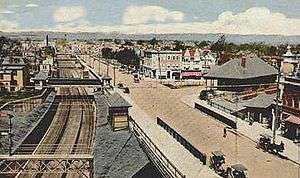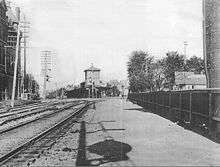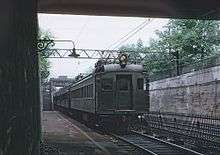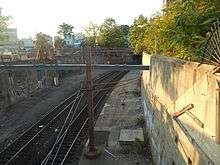Roseville Avenue station
Roseville Avenue was a transfer station on New Jersey Transit's Morris & Essex Lines (consisting of the Montclair Branch, Morristown Line and Gladstone Branch) in Newark, New Jersey, United States. The station was built by the Delaware, Lackawanna and Western Railroad in 1903 during a track depression to serve Newark's Roseville neighborhood. It once had two tracks (one each eastbound and westbound) on the Lackawanna mainline and two low-wall platforms, with an additional platform along the Montclair Branch. The station remained in service during most of the 20th century, until New Jersey Transit closed the station on September 16, 1984.
Roseville Avenue | ||||||||||||||||||||||||||||||||||||||
|---|---|---|---|---|---|---|---|---|---|---|---|---|---|---|---|---|---|---|---|---|---|---|---|---|---|---|---|---|---|---|---|---|---|---|---|---|---|---|
 A view of Seventh Avenue, Newark in the Roseville District in the early 1900s. The entirety of the station is visible in this aerial. | ||||||||||||||||||||||||||||||||||||||
| Location | Roseville Avenue and Seventh Avenue in Roseville, Newark, New Jersey | |||||||||||||||||||||||||||||||||||||
| Owned by | New Jersey Transit | |||||||||||||||||||||||||||||||||||||
| Line(s) | ||||||||||||||||||||||||||||||||||||||
| Tracks | 2 Montclair Branch, 3 Morris & Essex Lines | |||||||||||||||||||||||||||||||||||||
| Other information | ||||||||||||||||||||||||||||||||||||||
| Station code | 409 (Morris and Essex Railroad)[1] 600 (Montclair Branch)[1] | |||||||||||||||||||||||||||||||||||||
| History | ||||||||||||||||||||||||||||||||||||||
| Closed | September 16, 1984[2] | |||||||||||||||||||||||||||||||||||||
| Rebuilt | December 1905[3] | |||||||||||||||||||||||||||||||||||||
| Electrified | September 1930[4] | |||||||||||||||||||||||||||||||||||||
| Previous names | Bloomfield Junction[5] | |||||||||||||||||||||||||||||||||||||
| Former services | ||||||||||||||||||||||||||||||||||||||
| ||||||||||||||||||||||||||||||||||||||
Today, the only landmarks that mark the former station site are a metal utility box labeled "Roseville," and several flights of concrete stairs in the sides of the concrete-lined depression in which the track of the Morristown Line runs between the East Orange and Newark Broad Street stations. Shortly east of this structure, the Montclair-Boonton Line splits from the Morristown Line on its way to Montclair, Boonton, and Denville.
Station structure
Roseville Avenue station consisted of two different sets of double track to serve passenger trains for the Delaware, Lackawanna, and Western Railroad's Montclair Branch (now the Montclair-Boonton Line) and the Delaware, Lackawanna, and Western Railroad's Morris & Essex Lines (now the Morristown Line and the Gladstone Branch). The tracks were 22 feet (6.7 m) below the street level, and the station below street level was a brick passenger station extending to the Roseville Avenue bridge at Seventh Avenue. The other structure stood on street level, above the cut, served the Morris and Essex Line just north of the fork at Roseville. The station had four platforms, two for the Montclair Branch and two for the Morristown/Gladstone Lines in both direction.[6]
Roseville Tower was the interlocking tower at street-level in Roseville that handled the nearby fork of the three lines (Montclair, Morristown and Gladstone). The tower was used on limited services, with only three different shifts, two of which were manned. The tower was run from 5 a.m. in the morning to 10 p.m. in the evening manned. The rest of the time, the tower was set on automatic.[6]
History
Original station and track depression

The original Roseville Avenue station dates back to the opening of the Morris & Essex Railroad Station in 1856, when tracks were constructed through the Roseville district of Newark.[7] These tracks ran between Orange Street and Seventh Avenue, until the Morris & Essex line branched off at Roseville Avenue and continued northwest, the original station serving both branches.[8] The station was designed with two platforms, one along each line, the Morris & Essex first made use of the Montclair Branch property in April 1868 after buying the Newark and Bloomfield Railroad.[9]
In April 1901, the Delaware, Lackawanna and Western Railroad announced track depression and raising throughout portions of the line through Newark and the Oranges. Although the depression went into Newark, most of the debate over localities of stations was basically into the Oranges.[10] In 1903, the track depression reached the Roseville Avenue Station, and the lines were depressed through Roseville.[6] The new station built during the track depression was of similar style, with the station in the middle of the five-track interlocking, with one platform servicing the Montclair Branch's two tracks and one for the Main Line's two tracks. Rather than crossing at-grade, Roseville Avenue was bridged over the tracks with a brand new street-level interlocking tower present at the intersection of Roseville and Seventh Avenues.[11]
Delaware, Lackawanna and Western, and Erie–Lackawanna ownership

During the ownership of the Delaware, Lackawanna and Western Railroad, Roseville Avenue prospered, soon receiving sixty-eight stops by trains daily. This caught attention during a 1913 complaint to the New Jersey Board of Public Utilities by Charles McCausland. The major complaint from McCausland cited that the Lackawanna was not providing quality seating service on trains that stop at Roseville, and several which led to overcrowding, while several bypassing trains did not suffer from such effects. The plaintiff, McCausland, cited that the need for the sixty-eight trains was "additional but unnecessary". The Board of Public Utility Commissioners did not justify any changes or wrongdoing by the railroad, and as a result, no changes to service were made at Roseville Avenue.[12]
The station continued receiving major service over the next five decades, but by 1966, fewer trains stopped at the station, with limited daily service to the station past the 4:33 p.m. train from Hoboken Terminal.[13] Six years later, on June 24, 1972, the Erie–Lackawanna Railroad, who now maintained the station, announced further cutbacks on station service, axing twenty-three train stops at Roseville Avenue for both directions of service. The changes were made as part of major commuter service appropriations and the lack of patronage at the station. From that point, Roseville Avenue went from 37 westbound trains to 14, while eastbound was cut from 37 to 16. Service on Saturdays were cut to flag stops only, while the station received no Sunday service at all.[14] On April 1, 1976, the Erie–Lackawanna Railroad became defunct, and merged into Consolidated Rail Corporation (Conrail), with service sponsored by the New Jersey Department of Transportation.[6]
New Jersey Transit use and eventual closure

After the takeover of service along the former Morris & Essex Lines by New Jersey Transit from Conrail in 1982, the service at the Roseville Avenue station remained minimal. Many trains bypassed the station in favor of going to the nearby Newark Broad Street Station.[15] Trains continued to serve the Roseville Avenue station throughout 1982 and 1983, and service continued to be condensed during 1984. However, as of the official September 1984 timetables, service was cut from Roseville Avenue in favor of Newark Broad Street to Grove Street, East Orange (on the Morris & Essex) or Ampere (on the Montclair Branch), both of which closed in April 1991.[16] On September 16, 1984, trains began bypassing Roseville Avenue, and the station was closed permanently.[2] Although the station was closed, Roseville Tower, for the interlocking between the Montclair Branch and Morris & Essex Lines, remained in service for almost two more decades. In 2002, during construction of the Montclair Connection, the tower was demolished in favor of expanding the cut in Roseville for a second track of the new Montclair-Boonton Line.[6]
Notes
- "List of Station Numbers". Delaware, Lackawanna and Western Railroad. 1952. p. 2. Retrieved June 2, 2019.
- Morris & Essex Lines Timetable (September 16, 1984 ed.). Newark, New Jersey: New Jersey Transit Rail Operations. 1984.
- Taber & Taber 1980, p. 70
- "Montclair Connection Opening Draws Near". Newark, New Jersey: New Jersey Transit Rail Operations. December 5, 2001. Retrieved 8 February 2010.
- Taber & Taber 1981, p. 727
- Yanosey, Robert J. (2007). Lackawanna Railroad Facilities (In Color). Volume 1: Hoboken to Dover. Scotch Plains, New Jersey: Morning Sun Books Inc. pp. 52–53, 80. ISBN 1-58248-214-4.
- Urquhart, Frank John (1913). A History of the city of Newark, New Jersey. Volume 1. Lewis Historical Publishing Company.
- "Roseville Avenue station photograph". Roseville, Newark, New Jersey: Publisher unknown. 1890s. Retrieved 8 February 2010.
- Travelers' official Guide of the Railways (1870 ed.). National Railway Publication Company. June 1, 1870.
- "Suburban Railroad Changes" (PDF). The New York Times. New York, New York: Time Warner. April 28, 1901. p. 2. Retrieved 8 February 2010.
- "Roseville Avenue station photograph". Roseville, Newark, New Jersey: Publisher unknown. 1903. Retrieved 8 February 2010.
- Annual report of the Board of Public Utility Commissioners of the State of New Jersey (7 ed.). Trenton, New Jersey: Board of Public Utility Commissioners of the State of New Jersey. 1913. Retrieved 8 February 2010.
- Morris & Essex Lines Timetable (October 30, 1966 ed.). Hoboken, New Jersey: Erie–Lackawanna Railroad. 1966.
- Prial, Frank J. (June 24, 1972). "Erie-Lackawanna Plans To Add Commuter Trains". The New York Times. New York, New York: Time Warner. p. 62.
- Morristown Line – Gladstone Branch – Montclair Branch Timetables (October 31, 1982 ed.). Newark, New Jersey: New Jersey Transit Rail Operations. 1982.
- Morris & Essex Lines Timetable (April 7. 1991 ed.). Newark, New Jersey: New Jersey Transit Rail Operations. 1991.
References
- Taber, Thomas Townsend; Taber, Thomas Townsend III (1980). The Delaware, Lackawanna & Western Railroad in the Twentieth Century. 1. Muncy, PA: Privately printed. ISBN 0-9603398-2-5.CS1 maint: ref=harv (link)
- Taber, Thomas Townsend; Taber, Thomas Townsend III (1981). The Delaware, Lackawanna & Western Railroad in the Twentieth Century. 2. Muncy, PA: Privately printed. ISBN 0-9603398-3-3.CS1 maint: ref=harv (link)
External links
| Wikimedia Commons has media related to Roseville Avenue (NJT station). |
- The Roseville Train Stations – Pictorial narrative of the Newark, NJ Roseville Train Station.
- Description of the Montclair-Boonton line that mentions the Roseville Avenue location